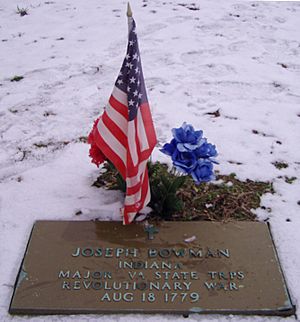Joseph Bowman facts for kids
Quick facts for kids
Joseph Bowman
|
|
|---|---|

Joseph Bowman grave marker, at St. Francis Xavier Cathedral Cemetery, near George Rogers Clark National Historical Park, Vincennes, Indiana
|
|
| Born |
Joseph Lawrence Bowman
c. March 8, 1752 |
| Died | August 14 or 15, 1779 (aged 27) Fort Patrick Henry, near Vincennes, Indiana, then part of Illinois County, Virginia, present-day Knox County, Indiana
|
| Cause of death | burn wounds from gunpowder explosion |
| Resting place | originally along the Wabash River, near Vincennes, Indiana, present-day St. Francis Xavier Cathedral Cemetery, near George Rogers Clark National Historical Park, Vincennes, Indiana |
| Nationality | American |
| Other names | Captain Bowman, Major Bowman |
| Occupation | frontiersman, hunter, farmer, soldier, state militia officer |
| Parent(s) | George Bowman and Mary Hite, Anglicized from Hans Georg Baumann and Marie Elisabetha Hite |
| Relatives | Jost Hite (grandfather), John (Johannes) Bowman (brother), Isaac Bowman (brother), Abraham Bowman (brother) |
Joseph Bowman (born around 1752 – died August 14 or 15, 1779) was an American soldier and officer. He served in the Virginia militia during the American Revolutionary War. Bowman was a key leader in Colonel George Rogers Clark's important military mission in 1778. This mission aimed to capture the Illinois Country from the British. Clark and his soldiers successfully took control of the British-held towns of Kaskaskia, Cahokia, and Vincennes.
After the British forces were defeated in Vincennes in 1779, Bowman was badly hurt in an accidental explosion. He later died from his injuries. He was the only American officer to die during the 1778-1779 Illinois campaign. Joseph Bowman also kept a daily diary of his journey from Kaskaskia to Vincennes. This diary is a very important record of Clark's successful campaign.
Contents
Early Life and Frontier Days
Joseph Bowman was born in Frederick County, Virginia. His parents were George Bowman and Mary Hite. His mother's father, Jost Hite, was a German immigrant. He was one of the first European settlers to move west of the Blue Ridge Mountains in Virginia. In 1732, Jost Hite brought his family, including Joseph's parents, to the Shenandoah Valley. This area is near what is now Winchester. Joseph Bowman grew up at Fort Bowman, close to modern-day Strasburg.
In 1774, Joseph Bowman joined the Virginia colonial militia. He fought in a conflict known as Lord Dunmore's War. Other future American heroes, like George Rogers Clark, also served in this war. Soon after, Bowman moved to Kentucky. Many British colonists were moving there to find new land on the western frontier. By 1777, Joseph Bowman was living in a settlement called Harrodstown. This is now Harrodsburg. One day, while working on his property, Bowman and 37 other men were attacked by Native Americans. One settler was killed and six were wounded before the attackers left.
Serving in the Revolutionary War
Joseph Bowman and three of his brothers fought in the American Revolutionary War. Joseph Bowman was a captain in George Rogers Clark's Illinois campaign. He was there when Fort Gage in Kaskaskia was captured on July 4, 1778. Captain Bowman then led a group of American and local French soldiers north. They captured Prairie du Rocher and Cahokia. Bowman stayed in Cahokia for a while, commanding the fort, which was renamed Fort Bowman.
Later in 1778, Fort Sackville (also called Fort Patrick Henry) was captured by British Lieutenant Governor Henry Hamilton. Captain Leonard Helm, the American commander, was also captured. In February 1779, Captain Bowman marched with Colonel Clark across 180 miles (290 km). Their goal was to attack the British forces at Vincennes. Joseph Bowman helped with the talks that led to the British surrender. After the British gave up, the American flag was raised. The fort was renamed Fort Patrick Henry on February 24, 1779.
Just a few days later, a message arrived from the Governor of Virginia. It announced that Clark was promoted to general and Bowman to major. For his service, Major Bowman was given a large amount of land. This land was north of the Ohio River and was known as "Clark's Grant."
Death and Legacy
To celebrate the end of General Clark's Illinois campaign, a cannon was fired on February 25, 1779. During this cannon salute, some gunpowder accidentally exploded. This accident wounded Captain Edward Worthington, four other soldiers, a captured British soldier, and badly injured Captain Bowman. General Clark did not mention this accident in his own writings. However, Clark did describe Major Bowman leading soldiers as late as June 1779.
Major Bowman's health got worse because of his severe burn wounds. He died at Fort Patrick Henry on August 14, 1779. The last page of his journal is blank, except for a note that says: "God save the [Virginia] commonwealth, this 15th day of August, 1779." A bronze grave marker was later placed in the St. Francis Xavier Cemetery. This cemetery is next to the George Rogers Clark National Historical Park in Vincennes, Knox County, Indiana. He was originally buried somewhere along the Wabash River.
Images for kids


